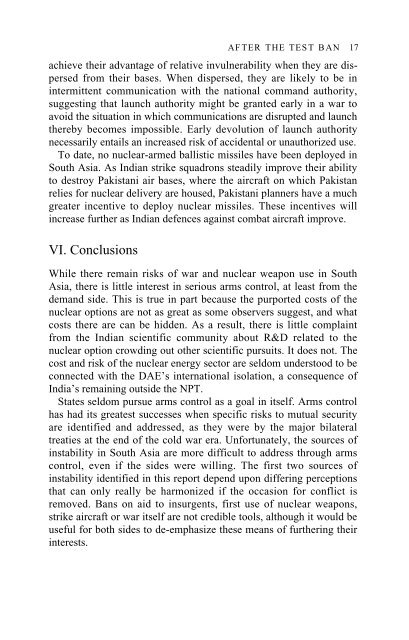Nuclear Weapons and Arms Control in South Asia after the Test Ban
Nuclear Weapons and Arms Control in South Asia after the Test Ban
Nuclear Weapons and Arms Control in South Asia after the Test Ban
Create successful ePaper yourself
Turn your PDF publications into a flip-book with our unique Google optimized e-Paper software.
AFTER THE TEST BAN 17<br />
achieve <strong>the</strong>ir advantage of relative <strong>in</strong>vulnerability when <strong>the</strong>y are dispersed<br />
from <strong>the</strong>ir bases. When dispersed, <strong>the</strong>y are likely to be <strong>in</strong><br />
<strong>in</strong>termittent communication with <strong>the</strong> national comm<strong>and</strong> authority,<br />
suggest<strong>in</strong>g that launch authority might be granted early <strong>in</strong> a war to<br />
avoid <strong>the</strong> situation <strong>in</strong> which communications are disrupted <strong>and</strong> launch<br />
<strong>the</strong>reby becomes impossible. Early devolution of launch authority<br />
necessarily entails an <strong>in</strong>creased risk of accidental or unauthorized use.<br />
To date, no nuclear-armed ballistic missiles have been deployed <strong>in</strong><br />
<strong>South</strong> <strong>Asia</strong>. As Indian strike squadrons steadily improve <strong>the</strong>ir ability<br />
to destroy Pakistani air bases, where <strong>the</strong> aircraft on which Pakistan<br />
relies for nuclear delivery are housed, Pakistani planners have a much<br />
greater <strong>in</strong>centive to deploy nuclear missiles. These <strong>in</strong>centives will<br />
<strong>in</strong>crease fur<strong>the</strong>r as Indian defences aga<strong>in</strong>st combat aircraft improve.<br />
VI. Conclusions<br />
While <strong>the</strong>re rema<strong>in</strong> risks of war <strong>and</strong> nuclear weapon use <strong>in</strong> <strong>South</strong><br />
<strong>Asia</strong>, <strong>the</strong>re is little <strong>in</strong>terest <strong>in</strong> serious arms control, at least from <strong>the</strong><br />
dem<strong>and</strong> side. This is true <strong>in</strong> part because <strong>the</strong> purported costs of <strong>the</strong><br />
nuclear options are not as great as some observers suggest, <strong>and</strong> what<br />
costs <strong>the</strong>re are can be hidden. As a result, <strong>the</strong>re is little compla<strong>in</strong>t<br />
from <strong>the</strong> Indian scientific community about R&D related to <strong>the</strong><br />
nuclear option crowd<strong>in</strong>g out o<strong>the</strong>r scientific pursuits. It does not. The<br />
cost <strong>and</strong> risk of <strong>the</strong> nuclear energy sector are seldom understood to be<br />
connected with <strong>the</strong> DAE’s <strong>in</strong>ternational isolation, a consequence of<br />
India’s rema<strong>in</strong><strong>in</strong>g outside <strong>the</strong> NPT.<br />
States seldom pursue arms control as a goal <strong>in</strong> itself. <strong>Arms</strong> control<br />
has had its greatest successes when specific risks to mutual security<br />
are identified <strong>and</strong> addressed, as <strong>the</strong>y were by <strong>the</strong> major bilateral<br />
treaties at <strong>the</strong> end of <strong>the</strong> cold war era. Unfortunately, <strong>the</strong> sources of<br />
<strong>in</strong>stability <strong>in</strong> <strong>South</strong> <strong>Asia</strong> are more difficult to address through arms<br />
control, even if <strong>the</strong> sides were will<strong>in</strong>g. The first two sources of<br />
<strong>in</strong>stability identified <strong>in</strong> this report depend upon differ<strong>in</strong>g perceptions<br />
that can only really be harmonized if <strong>the</strong> occasion for conflict is<br />
removed. <strong>Ban</strong>s on aid to <strong>in</strong>surgents, first use of nuclear weapons,<br />
strike aircraft or war itself are not credible tools, although it would be<br />
useful for both sides to de-emphasize <strong>the</strong>se means of fur<strong>the</strong>r<strong>in</strong>g <strong>the</strong>ir<br />
<strong>in</strong>terests.

















